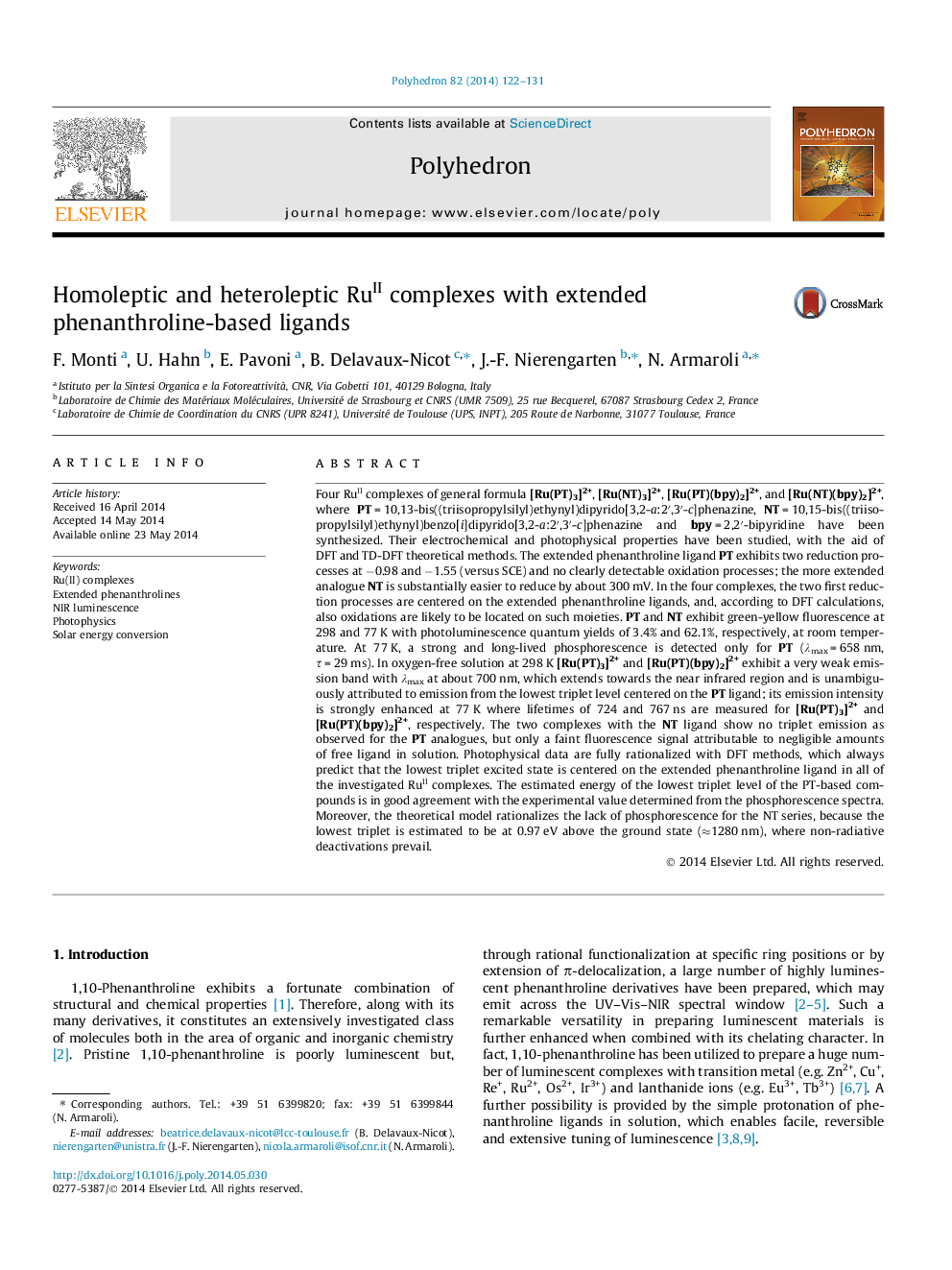| کد مقاله | کد نشریه | سال انتشار | مقاله انگلیسی | نسخه تمام متن |
|---|---|---|---|---|
| 1336446 | 1500257 | 2014 | 10 صفحه PDF | دانلود رایگان |
Four RuII complexes of general formula [Ru(PT)3]2+, [Ru(NT)3]2+, [Ru(PT)(bpy)2]2+, and [Ru(NT)(bpy)2]2+, where PT = 10,13-bis((triisopropylsilyl)ethynyl)dipyrido[3,2-a:2′,3′-c]phenazine, NT = 10,15-bis((triisopropylsilyl)ethynyl)benzo[i]dipyrido[3,2-a:2′,3′-c]phenazine and bpy = 2,2′-bipyridine have been synthesized. Their electrochemical and photophysical properties have been studied, with the aid of DFT and TD-DFT theoretical methods. The extended phenanthroline ligand PT exhibits two reduction processes at −0.98 and −1.55 (versus SCE) and no clearly detectable oxidation processes; the more extended analogue NT is substantially easier to reduce by about 300 mV. In the four complexes, the two first reduction processes are centered on the extended phenanthroline ligands, and, according to DFT calculations, also oxidations are likely to be located on such moieties. PT and NT exhibit green-yellow fluorescence at 298 and 77 K with photoluminescence quantum yields of 3.4% and 62.1%, respectively, at room temperature. At 77 K, a strong and long-lived phosphorescence is detected only for PT (λmax = 658 nm, τ = 29 ms). In oxygen-free solution at 298 K [Ru(PT)3]2+ and [Ru(PT)(bpy)2]2+ exhibit a very weak emission band with λmax at about 700 nm, which extends towards the near infrared region and is unambiguously attributed to emission from the lowest triplet level centered on the PT ligand; its emission intensity is strongly enhanced at 77 K where lifetimes of 724 and 767 ns are measured for [Ru(PT)3]2+ and [Ru(PT)(bpy)2]2+, respectively. The two complexes with the NT ligand show no triplet emission as observed for the PT analogues, but only a faint fluorescence signal attributable to negligible amounts of free ligand in solution. Photophysical data are fully rationalized with DFT methods, which always predict that the lowest triplet excited state is centered on the extended phenanthroline ligand in all of the investigated RuII complexes. The estimated energy of the lowest triplet level of the PT-based compounds is in good agreement with the experimental value determined from the phosphorescence spectra. Moreover, the theoretical model rationalizes the lack of phosphorescence for the NT series, because the lowest triplet is estimated to be at 0.97 eV above the ground state (≈1280 nm), where non-radiative deactivations prevail.
RuII complexes with dppz- and dppn-type ligands equipped with (triisopropylsilyl)ethynyl residues exhibit low-lying ligand centered ππ∗ triplet excited states, as determined by DFT calculations. In the case of the homoleptic and heteroleptic complexes with the smaller ligand, luminescence in the near infrared region is observed, while the larger analogues have excited states below 1 eV and undergo non-radiative deactivation.Figure optionsDownload as PowerPoint slide
Journal: Polyhedron - Volume 82, 4 November 2014, Pages 122–131
